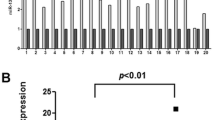Abstract
Family with sequence similarity 83 (FAM83) members play important roles in carcinogenesis and tumor progression in several tumor types. However, the mechanism by which cancer cells regulate FAM83F still remains unclear. In this study, we found that the FAM84F protein and messenger RNA (mRNA) levels were consistently upregulated in esophageal squamous cell carcinoma (ESCC) tissues, which suggests that a post-transcriptional mechanism may be involved in the regulation of FAM83F. Since microRNAs (miRNAs) are powerful post-transcriptional regulators of gene expression, we performed bioinformatic analyses to search for miRNAs that could potentially target FAM83F. We identified the specific targeting site of miR-143 in the 3′-untranslated region (3′-UTR) of FAM83F and confirmed the inverse correlation between the levels of miR-143 and FAM83F protein and mRNA in ESCC tissue samples. By overexpressing or silencing miR-143 in ESCC cells, we experimentally validated that miR-143 directly binds to the 3′-UTR of the FAM83F transcript and degrades the FAM83F mRNA to regulate FAM83F expression. Furthermore, the biological consequences that miR-143 mediated by targeting FAM83F were examined using in vitro cell proliferation, apoptosis, migration, and invasion assays. We demonstrate that miR-143 exerted a tumor-suppressing effect by inhibiting the proliferation, migration, and invasion and inducing G1/G0 phase arrest of ESCC cells via the negative regulation of FAM83F expression. Taken together, our findings provide important evidence which supports the role of miR-143 as a tumor suppressor in ESCC via the inhibition of FAM83F expression.








Similar content being viewed by others
References
Siewert JR, Ott K. Are squamous and adenocarcinomas of the esophagus the same disease? Semin Radiat Oncol. 2007;17(1):38–44. doi:10.1016/j.semradonc.2006.09.007.
Mathe EA, Nguyen GH, Bowman ED, Zhao Y, Budhu A, Schetter AJ, et al. MicroRNA expression in squamous cell carcinoma and adenocarcinoma of the esophagus: associations with survival. Clin Cancer Res. 2009;15(19):6192–200. doi:10.1158/1078-0432.CCR-09-1467.
Huang J, Zhang SY, Gao YM, Liu YF, Liu YB, Zhao ZG, et al. MicroRNAs as oncogenes or tumour suppressors in oesophageal cancer: potential biomarkers and therapeutic targets. Cell Prolif. 2014;47(4):277–86.
Cipriano R, Miskimen KL, Bryson BL, Foy CR, Bartel CA, Jackson MW. Conserved oncogenic behavior of the FAM83 family regulates MAPK signaling in human cancer. Mol Cancer Res. 2014;12(8):1156–65. doi:10.1158/1541-7786.MCR-13-0289.
Roush SF, Slack FJ. Micromanagement: a role for microRNAs in mRNA stability. ACS Chem Biol. 2006;1(3):132–4. doi:10.1021/cb600138j.
Hwang HW, Mendell JT. MicroRNAs in cell proliferation, cell death, and tumorigenesis. Br J Cancer. 2007;96(Suppl):R40–4.
Calin GA, Croce CM. MicroRNA signatures in human cancers. Nat Rev Cancer. 2006;6(11):857–66. doi:10.1038/nrc1997.
Song Y, Li L, Ou Y, Gao Z, Li E, Li X, et al. Identification of genomic alterations in oesophageal squamous cell cancer. Nature. 2014;509(7498):91–5. doi:10.1038/nature13176.
Livak KJ, Schmittgen TD. Analysis of relative gene expression data using real-time quantitative PCR and the 2(-Delta Delta C(T)) Method. Methods. 2001;25(4):402-8. doi:10.1006/meth.2001.1262
Lee SY, Meier R, Furuta S, Lenburg ME, Kenny PA, Xu R, et al. FAM83A confers EGFR-TKI resistance in breast cancer cells and in mice. J Clin Invest. 2012;122(9):3211–20. doi:10.1172/JCI60498.
Li JM, Zhao RH, Li ST, Xie CX, Jiang HH, Ding WJ, et al. Down-regulation of fecal miR-143 and miR-145 as potential markers for colorectal cancer. Saudi Med J. 2012;33(1):24–9.
Koo S, Martin GS, Schulz KJ, Ronck M, Toussaint LG. Serial selection for invasiveness increases expression of miR-143/miR-145 in glioblastoma cell lines. BMC Cancer. 2012;12:143. doi:10.1186/1471-2407-12-143.
Xu B, Niu X, Zhang X, Tao J, Wu D, Wang Z, et al. miR-143 decreases prostate cancer cells proliferation and migration and enhances their sensitivity to docetaxel through suppression of KRAS. Mol Cell Biochem. 2011;350(1-2):207–13.
Wu BL, Xu LY, Du ZP, Liao LD, Zhang HF, Huang Q, et al. miRNA profile in esophageal squamous cell carcinoma: downregulation of miR-143 and miR-145. World J Gastroenterol. 2011;17(1):79–88.
Zhou K, Yan Y, Zhao S. Esophageal cancer-selective expression of TRAIL mediated by MREs of miR-143 and miR-122. Tumour Biol. 2014;35(6):5787–95. doi:10.1007/s13277-014-1768-5.
Author information
Authors and Affiliations
Corresponding author
Ethics declarations
We declare that all human and animal studies have been approved by the hospital ethics committee and have therefore been performed in accordance with the ethical standards laid down in the 1964 Declaration of Helsinki and its later amendments. We declare that all patients gave informed consent prior to inclusion in this study.
Additional information
An erratum to this article is available at http://dx.doi.org/10.1007/s13277-016-5470-7.
Rights and permissions
About this article
Cite this article
Mao, Y., Liu, J., Zhang, D. et al. miR-143 inhibits tumor progression by targeting FAM83F in esophageal squamous cell carcinoma. Tumor Biol. 37, 9009–9022 (2016). https://doi.org/10.1007/s13277-015-4760-9
Received:
Accepted:
Published:
Issue Date:
DOI: https://doi.org/10.1007/s13277-015-4760-9




